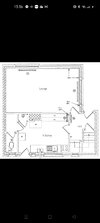Unless you chop off the top of the kick-up leaving it so that you can just sit the skirting onto a more or less flat surface, you have to produce a skirting with a "razor edge" bottom. Not too bad for a couple of feet of material (you referred to skill levels, and that is also my concern), but somewhat more awkward for long lengths.
So the approach is going to be influenced by whatever material this stuff is. I've seen kick-ups like this in timber and a sort of render (coarse, sandy stuff with small stones in it), but the OPs photo has me thinking it may be some sort of composite stone (e.g. terrazzo). I wonder why they'd use that, unless the whole floor beneath they vinyl is also terrazzo?
@dobby101, what is the floor beneath the vinyl made of? Also, do you know what the room was originaly used for? Having thought about terrazzo, I'm put in mind of certain public spaces where the floors would normally be mopped to clean them and the floor and kick-up floor edges were cast as one (e.g. corridors, commercial kitchens, wet shop areas such as florists and butchers, public toilets, etc). Not common these days, but popular in the last century


